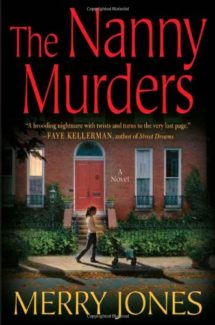 Something is Sinister in Suburbia
Something is Sinister in Suburbia
Author: Merry Jones
Divorcee Zoe Hayes works as an art therapist at an institution; most of her patients are completely deranged, many even dangerous, all with low prospects of getting better and no hopes of leaving the sterile institution that echoes with their own internal fears. Yet, even here Zoe finds a sunny sort of happiness in doing something worthwhile, guiding her patients through honest, if pointless, interactions with art.
Zoe’s divorce has finally been settled and her ex is not satisfied with the mostly amicable terms. This week it’s her wedding ring, which he wants to give to his new fiancé. Next week it will be something else. Zoe is intent on ignoring the bad and concentrating on the good, the fulfillment of her lifelong desire to be a mother, embodied by her adopted daughter Molly. With Molly by her side, life by herself is not such a bad prospect. Until nannies start missing, that is, and her little girl is the first to discover a severed body part, lying on the snowy sidewalk.
 The thing is, everyone in her stalled, gentrifying neighborhood is a prime suspect: Victor, the recluse whose twitching bedroom curtains are the only evidence that he is still alive; Charlie, the elderly and caring neighbor who has been acting rather strange and feverish lately; Phillip Woods, seemingly normal but oddly attached to the case’s sexy female profiler; Nick Stiles, the hunky lead detective with the shady past and an inclination to edit gory details; Zoe’s ex-husband with his endless stalking; even her daughter’s gymnastics coach, who seems to have harbored unreturned crushes on each of the missing nannies. As the story develops and more nannies go missing, Zoe is inexorably drawn into both the investigation and the neighborhood vigilante panic.
The thing is, everyone in her stalled, gentrifying neighborhood is a prime suspect: Victor, the recluse whose twitching bedroom curtains are the only evidence that he is still alive; Charlie, the elderly and caring neighbor who has been acting rather strange and feverish lately; Phillip Woods, seemingly normal but oddly attached to the case’s sexy female profiler; Nick Stiles, the hunky lead detective with the shady past and an inclination to edit gory details; Zoe’s ex-husband with his endless stalking; even her daughter’s gymnastics coach, who seems to have harbored unreturned crushes on each of the missing nannies. As the story develops and more nannies go missing, Zoe is inexorably drawn into both the investigation and the neighborhood vigilante panic.
From its brooding suburban cover, oddly cozy, and the jacket write-up readers expect a lighter version of a Mary Higgins Clark novel mixed in with the pleasures of cooling weather, corduroy jackets, and the sinister rustling of leaves along abandoned streets. Instead, Nanny Murders positions itself somewhere between a formulaic thriller and a serial killer slasher. For all the misnomers, forced twists and turns, and imminent peril of the heroine and her unfortunate daughter, alongside a crisis romance, the novel is still oddly sedate though, undermining its own attempts at edge-of-the-seat confrontations and slowly escalating investigations. Perhaps it’s trying too hard or, conversely, not trying enough.
Zoe is the only character with significant page time. She is, unarguably, the protagonist and yet something about her is distant or perhaps just not relatable. Her day job can only be described as depressing, and yet she never admits the deeper trauma of the situations she is constantly surrounded by, the murderous thoughts of the patients slowly emerging on canvas. She reacts as though it’s nothing more than story time with some quaint toddlers, meaning she is either naïve or oblivious. As the story progresses, her disconnection grows. Charlie, her suddenly deranged neighbor who claims to share a mental wave length with the killer, whom he likewise claims to know, is steadily ignored by Zoe. Readers recognize all the obvious, boulder sized hints from the author and the “all is not right” with the world vibe. How is Zoe steadily missing it, much less brushing these encounters off as normal? Why doesn’t she just ask Charlie who the killer is, or at least actively seek help for him?
 Then, as the killer does his stuff in the background, Zoe starts to fall for the hunky but haunted detective, and we put aside bags full of body parts (a little far even for Higgins I’d say) to discuss loving and trusting again post-divorce. Once again, Zoe doesn’t quite ring true to us. Her hurt over her ex, who endlessly appears, is merely lip service, whereas deeper feelings of betrayal and frustration never manifest.
Then, as the killer does his stuff in the background, Zoe starts to fall for the hunky but haunted detective, and we put aside bags full of body parts (a little far even for Higgins I’d say) to discuss loving and trusting again post-divorce. Once again, Zoe doesn’t quite ring true to us. Her hurt over her ex, who endlessly appears, is merely lip service, whereas deeper feelings of betrayal and frustration never manifest.
Zoe’s headlong romance with the lead detective, Nick, soon falls from the grace of new love into the depths of suspicion. Despite their, ahem, sudden closeness, Nick won’t dish the juicy investigation details, and Zoe knows this makes him dishonest, inherently dangerous, and somehow usurious. It hardly matters that she is still a civilian and that this relationship is in an early, vulnerable phase – the man certainly not owing her the keys to his soul, much less confidential details of his public service job. Zoe responds by mounting an over-the-top emotional response, a passive-aggression that is redolent of an adolescent’s first toe tap into the pools of murky romance. And this woman has been married before? Has interacted in society? Is raising a child? Is somehow convinced that she, and only she, can catch a clever killer?
Naturally, as the novel continues the number one thriller mistake occurs – the cop seeks the civilian’s input on the investigation and wants her to review the psychologist’s profile to see if any locals fall under the umbrella of potential nannynapper (yes, that’s the word they use). From here, the last shred of reality drifts away, forgotten. We transition then from sudden confrontations and multiple “I’ve caught him” moments only to arrive back in danger, all the previous assumptions destroyed by new and sudden revelations. Zoe ends up essentially confronting the dangerous killer at least three times before finally landing with the right one and an explanation that was clearly evident from the first several chapters. It tries to be sinuous, shocking, and sneaky. Instead, it feels contrived, as though the author is playing a game of cat and mouse with us, enjoying our frustrated scrambling, almost making fun of our intelligence – did we really fall for that after all.
The darkness of the tale itself, its brooding sense of a noir movie, including a few “shocker” moments of brutal gore and the left-field danger scenarios (admittedly, usually several better than average chapters in a row) interspersed with the otherwise sleepy atmosphere of the novel give it an uneven sense. The idea is certainly there and yet, something about the bleak, icy atmosphere and the jarring movements interspersed with quiet chapters (meant to highlight paranoia) leaves us slightly depressed and mostly unimpressed. We don’t buy any of it. In the end, these people are never characters; this tragedy is never real, its repercussions and body count a child’s gruesome fireside fiction, its hinting ending in a set-up for a sequel, which is just another part of some campy horror tradition, half-forgotten in the fading glow of the story’s ending.
– Frances Carden
Follow my reviews on Twitter at: https://twitter.com/xombie_mistress
Follow my reviews on Facebook at: https://www.facebook.com/FrancesReviews/
[AMAZONPRODUCTS asin=”0312330383″]
- Book Vs Movie: The Shining - April 6, 2020
- Thankful For Great Cozy Mysteries - December 13, 2019
- Cozy Mysteries for a Perfect Fall - October 20, 2019


